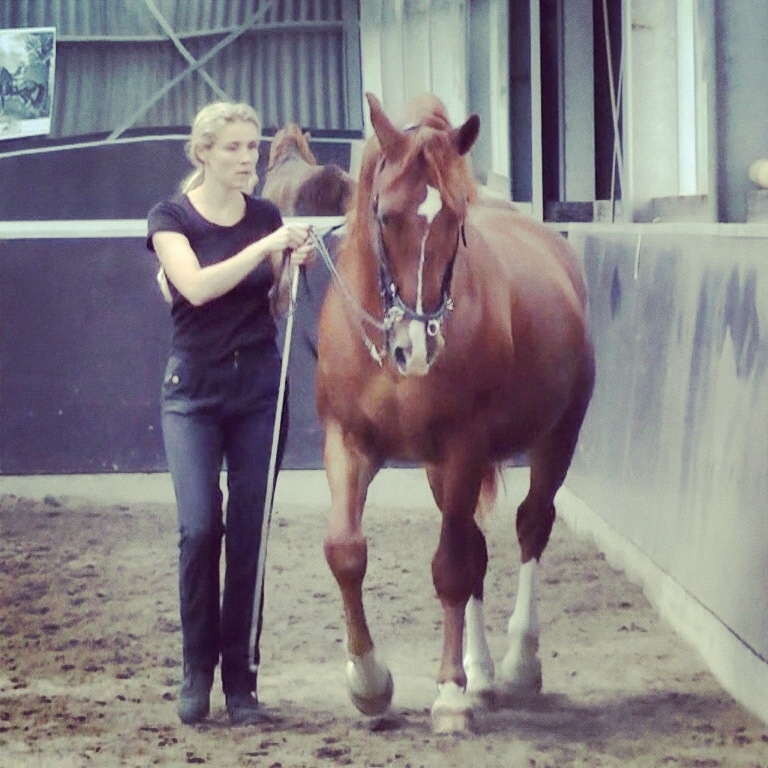
Work in hand
Work in hand is another important training pillar of straightness training.
When your horse horse is well prepared by groundwork and longeing, you can start with work in hand,
Work in hand is done using a cavesson and reins. As you become more advanced, you can use a combination of cavesson and bit during work in hand and use two reins.
The goal of work in hand is to supple up the horse to both sides, to teach the horse all straightness training exercises and to prepare the horse for riding.
You can teach your horse all lateral movements in hand from the ground. This way you are able to observe your horse from the ground in all exercises and in all gaits and, for example, see which hind leg is the weakest.

6 Keys of Straightness Training
The structural theme in work in hand is – like in longeing – the LFS, which consists of the first three keys of straightness training:
- Key 1. L ateral bending
- Key 2. F orward-down tendency
- Key 3. S tepping under
In every exercise, the horse is asked to walk with correct lateral bending in order to cause it to release its back muscles, so that the head and neck will be in a forward-down position. It also brings forward the inside hip so that the inside hind leg is stepping under the center of mass.

Keys 4, 5 and 6 are also practiced in hand to take weight off the front legs:
……Key 4. Bending the inside hind leg
……Key 5. Bending the outside hind leg
……Key 6. Bending both hind legs

Exercises
In work in hand the horse is taught the following exercises, first in walk, then in trot and eventually also in canter:
1. Circle

On the circle, the horse learns to bend to both sides, in a forward-down position with a hind leg that steps under the weight.
2. Shoulder-in

When the horse feels supple on the inside rein, the outside rein can be used to ask the horse to bring its shoulders inwards.
In the exercise shoulder-in, the weight of the horse is placed in front of the direction of movement of the inside hind leg, thus making it carry more weight.
The wall prevents the outside hind leg from falling out.
3. Haunches-in

In haunches-in, the weight of the horse is placed in front of the direction of movement of the outside hind leg, thus making it carry more weight. Iin this exercise, you walk backwards so your horse is able to bring the hind quarters in.
4. Renvers

Renvers is practised in order to make the haunches-in more independent from the wall.
This exercise is started in shoulder-in on 4 tracks. Then the bending is changed, resulting in the renvers.
5. Half pass

Half pass is a renvers on the diagonal line in the arena, in which the horse no longer has any support from the wall.
It is important to keep the shoulders in front of the hips of the horse, to allow both hind legs to step towards the point of weight.
The start is as follows: The trainer turns away from the short side of the arena on a quarter-line (line between the wall and the center line) and changes the bend.
6. Pirouette

The pirouette is a renvers on a circle.
The start is as follows:
Make a large circle on the short side of the arena in walk. At X, change the bend and make a renvers circle in the other half of the arena.
A pirouette can be executed by gradually decreasing the size of the circle.
7. Piaffe

All exercises above can also be done in trot.
By collecting the trot more and more, you can train the so-called “half steps” in trot.
In the end, after an intensive training period, the horse has become so strong that it can trot in place, creating piaffe. In this exercise, both hind legs have to bend and carry.
8. Canter pirouette

All exercises above can also be done in canter. By collecting the canter more and more, you can train the so-called “working-pirouette”.
In the end, after an intensive training period, the horse has become so strong that it can canter with the hind legs around a small spot, creating the pirouette.
In this exercise, both hind legs have to bend and carry.
9. Levade

In the levade the horse carries 100% of its weight on the hindquarter, in which it bends its hind legs equally in the same moment.
The levade contributes to making the hindquarter more powerful and bendable.
The levade is the perfect check whether the horse is trained straight.

Canter pirouette

